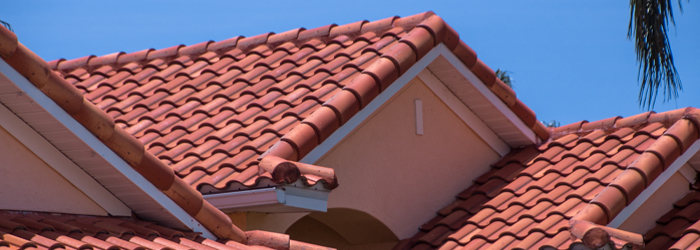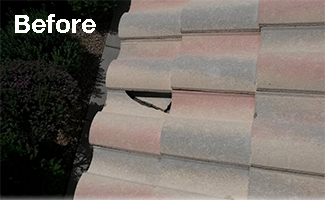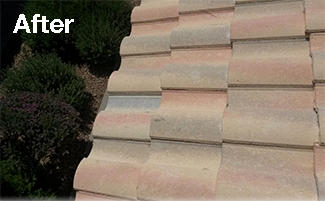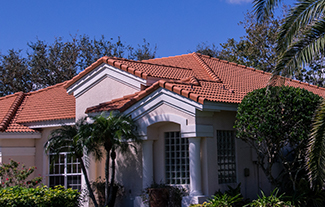Taking Care of Your Tile Roof
 14 April 2020
14 April 2020 

Protect Your Home By Protecting Your Roof
Tile roofs are a symbol of the southwest, rich in color, long lasting, and pleasing to the eye. If you have a tile roof, or any roof for that matter, you will want to keep it beautiful and in good working order. Longevity of the roof at your home will depend on many factors including the workmanship from when the house was originally built, how the roof has been maintained, and weather events.
Regular Maintenance | Keep Your EYE On It!
 One of the key things to remember, whether your tiles are made of concrete, clay, or sandcast clay, is they are all fragile and can be easily broken when walked on. It is not a good idea to jump up on the roof and walk around to have a look-see.
One of the key things to remember, whether your tiles are made of concrete, clay, or sandcast clay, is they are all fragile and can be easily broken when walked on. It is not a good idea to jump up on the roof and walk around to have a look-see.
However, there are things you can keep an eye on that provide a clue as to the health of your roof:
- Walk around the house from a distance and look at the tiles. Are there any broken or missing tiles?
- Tour the inside of your home and inspect the ceiling for any kind of water spotting or damage.
- Have your roof maintained on a yearly basis. There are many possible issues that are not visible from the ground that could cause roof leaks that can be prevented by proper maintenance.
Tyler Johnson of Johnson Roofing, a Rosie on the House Certified Partner recommends an annual checkup by your roofer to have them replace any missing tiles. Even one cracked tile can wreak havoc over time, allowing water leaks to develop. Another issue that can develop from broken or missing tile is sun damage and aging to the underlayment.
In addition, it is recommended that homeowners make a visual inspection at least two times (2x) a year as well as after any significant weather event like a hail or a dust storm. If there is evidence of leaks or damaged tile(s), have a licensed and bonded roofer come to your home. We don't recommend tile roof repair as a DIY task. In addition to the potential of damaging the tile there is also the risk of falling from a steep and/or slippery rooftop.

Failing Underlayment Requires Replacement
Though tiles on a roof can last 50 years or longer, the tiles are not actually what protects your home. There is a felt underlayment that keeps the water and weather out but unfortunately, it will not last as long as the tile. The underlayment, in the Arizona climate, will last between 8-20 years. Once the underlayment has lost its effectiveness, the house will be susceptible to leaks and must be replaced.
The only solution for rotted or aging underlayment is to replace it. This involves removing the tiles, replacing the underlayment and then putting the tiles back in place. For more information on Rosie's recommendation for replacing underlayment, check out Rosie's Roofing Consumer Guide.
Water Drainage That May Require Attention
Problem:
The angles where the tile roof comes together, known as tile roof valleys, can be an issue if the valley(s) ends before it comes to the edge of the roof. If they end in another tile instead of at the edge of the roof, water can get under the tile and into the underlayment. This can cause damage to the underlayment and the plywood base.
Solution:
The solution for this issue is to install a special flashing to redirect the water.
Problem:
Tile dead valleys. Dead valleys occur when a tile roof stops at a wall or roof angles come together in a fashion that creates a problem in draining, causing the water to collect in a pool or drain slowly. This is especially problematic, resulting in approximately 50% of leaks that we see on tile roofs.
Solution:
 Johnson's solution involves installing metal channels to redirect the water.
Johnson's solution involves installing metal channels to redirect the water.
Problem:
Broken tile. A single broken tile can cause $1000's in damage. The average cost of just a tile roof leak is 650-1500, depending on the amount of damage, and this is without considering any of the interior damage. A broken tile will eventually lead to a leak. It is not a question of if, just when. Tile breaks for many reasons, ranging from roof trafic, manufacturer's defect to simple expansion contraction. This is very common and considered a maintenance item on a tile roof. Approxomatly 25% of roof leaks that we see are a result of broken tile. One consideration on broken tile is that the roof leaks that we repair are typically the more expensive ones as this is a slow degradation of the underlayment and the areas affected tend to be large.
Solution:
A typical roof maintenance will include replacing broken tile. If caught in time there is no need to replace the underlayment. Johnson Roofing charges $350 for a basic tile roof maintenance. A simple roof maintenance will also check your entire roof as well as address other possible future issues such as lifted flashings, damaged mudballs and shifted tiles.
Stretched Tile: Replace or Repair?
Stretched tile is a term for tile that is laid too far apart. The requirement for laying tile roofing is 3" overlap. Spacing tiles too far apart and decreasing the overlay, allows water to get in between tiles and do a lot of damage over time.
If the stretching is over a small portion of the roof it might be a manageable repair. But, if the distance between tiles has been stretched throughout the entire roof, it will be necessary to take the tile off and relay it, thus requiring some extra tile.
Johnson says, "the unfortunate fact is that many of these issues are slow developing and the roof may be out of warranty before the need for repair is detected. It is very important to choose a reputable roofer who is experienced and honest."
When you need your roof replaced or repaired choose your roofer carefully. Make sure the contractor you use is at the very least licensed, bonded and insured. Repairing or replacing your roof is a big investment and effects not only the value of your home but the safety of all inside.
When to Repair:
If your underlayment is in overall good shape and you have a leak, oftentimes it is due to original improper installation and/or lack of maintenance over the life of the roof. In many cases a small localized repair is sufficient to stop the leak and give your roof many years of useful service. Your roof's useful lifespan can be greatly increased with regular maintenance and proper care.
When to Replace:
On a concrete tile roof unless the customer wants to change color of tile it is typically cost effective to reuse the existing tile. Your existing tile is oftentimes stronger than new tile due to concrete curing properties. Concrete in general will continually harden throughout its lifespan.
This means that while your tile is getting stronger over time, the underlayment does have an expected lifespan and after you reach this point you are living on borrowed time.
While there are many things to consider when replacing your roof we will focus on two:
- The quality of underlayment that is being installed. A Full Roof Replacement often has a bill that runs above $10,000. If you look at the overall job, the cost of the underlayment is usually less than 10-20% of the cost.But the underlayment is 100% of the reason you are going to the expense of re-doing your roof. Best practice in our industry is to install a double layer of underlayment. So if you were to increase the overall cost of the roof by 10-20% you could increase the expected lifespan by 100%.
- Ventilation. Many contractors out there will not talk to you about ventilation on your roof but the fact of the matter is that every single underlayment manufacturer may void their warranty if your roof is not properly ventilated. Especially in our climate proper roof ventilation is critical not only for a roofs performance but also for your overall heating and cooling bill.
###
SPONSORED BY: Johnson Roofing
 Since 2004 Johnson Roofing has been offering the highest quality roofing services in the valley of the sun. You can feel confident that you are getting not only the most professional service available, but the best pricing for your particular need. Johnson Roofing specializes in roofing repairs, replacements, and new roof installations. Doesn't matter if it is residential, commercial, or industrial, Johnson Roofing can assist you with any home roofing need.
Since 2004 Johnson Roofing has been offering the highest quality roofing services in the valley of the sun. You can feel confident that you are getting not only the most professional service available, but the best pricing for your particular need. Johnson Roofing specializes in roofing repairs, replacements, and new roof installations. Doesn't matter if it is residential, commercial, or industrial, Johnson Roofing can assist you with any home roofing need.
Photo Credits:
- Johnson Roofing
- Shutterstock
RELATED CONTENT:
- Blog: Three Roof Maintenance Tips For The Winter Season
- Blog: How Can I Prevent Monsoon Storms From Damaging My Flat Roof And Causing My Ceiling To Leak?
- DIY FAQ: Can Fixing A Small Leak In My Roof Get Me Through Monsoon Season?
- DIY FAQ: Rosie's Roofing Consumer Guide
- DIY FAQ: How To Hire A Contractor Consumer Guide
- Podcast: Whats On Your Roof In Arizona??
Print this page
recent post
- Duck, Duck, Duct! How Often Should Ductwork Be Cleaned?
- Vinyl vs. Fiberglass Windows: Which Is The Better Choice Of Replacement Window?
- We May Be The Grand Canyon State, But The Rocky Mountains Are Important For Arizona
- Welcome to Arizona! Things A Newbie to Arizona Should Know
- The Pros & Cons of Buying A Flipped House
- Getting In On The Ground Floor
- Why It’s More Critical Than Ever To Get Your AC Serviced Before Summer
- The Reality of Remodeling
- What To Look For When Comparing Your Roofing Quotes
- What To Expect When Buying New Windows & Doors
